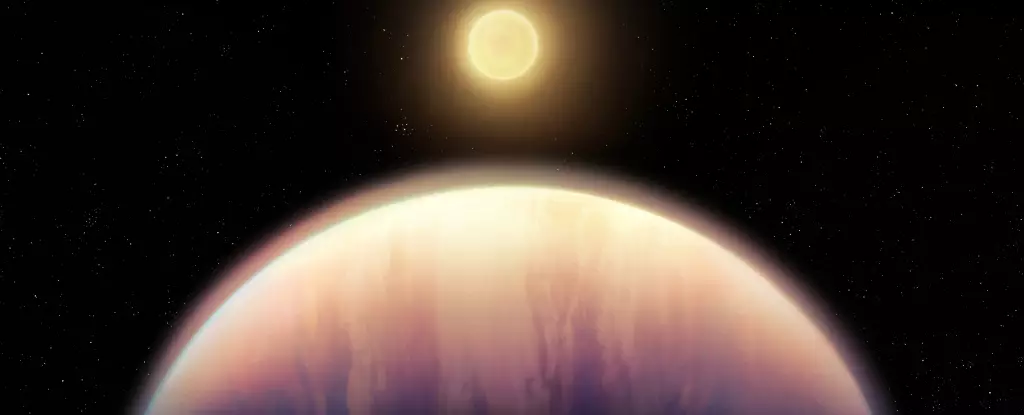The launch of the James Webb Space Telescope (JWST) has marked a transformative era in astronomical research, pushing the boundaries of what we know about exoplanets, particularly their atmospheres. Unlike its predecessors, the JWST is equipped with advanced technologies that enable detailed scrutiny of the gases surrounding distant planets. This groundbreaking capability opens a new chapter in our quest to understand not just exoplanets, but the very foundations of planetary systems and possibly the origins of life itself.
As JWST has recently demonstrated through its observations of the HR 8799 system, the telescope can analyze the light from a star as it filters through a planet’s atmosphere. This technique allows astronomers to detect elements such as carbon dioxide, revealing important insights into the formation processes of these celestial bodies. The implications of such findings are profound, as they suggest a potential parallel between the formation of the HR 8799 system and our own Solar System, igniting excitement and curiosity in the scientific community.
Understanding HR 8799: A Stellar Anomaly
Nestled within the constellation Pegasus, the HR 8799 system is a striking example of a young star system, located a mere 130 light-years away from Earth. This system stands out not just for its physical characteristics—a main-sequence star about 1.5 times the mass of our Sun—but also for its remarkable collection of four gas giants orbiting at vast distances from their host star, ranging from 15 to 70 astronomical units. These giants, dubbed HR 8799 b, c, d, and e, each boast masses between five to ten times that of Jupiter, making them not just interesting objects of study, but also critical to our understanding of planetary formation.
The HR 8799 system provides a unique opportunity to discuss the two principal theories of gas giant formation: core accretion and disk instability. Core accretion posits that solid cores form slowly, gradually attracting gas, while disk instability suggests that rapid coalescence occurs in a cooling disk surrounding a young star. The data processed from JWST observations indicate a tendency towards core accretion for the gas giants in HR 8799, a significant conclusion when compared to the well-studied Jupiter and Saturn of our own Solar System.
Decoding the Secrets of Carbon Dioxide
The JWST’s recent findings of substantial carbon dioxide presence in the atmospheres of the HR 8799 planets build a compelling case for core accretion models. Dr. William Balmer, a leading researcher from Johns Hopkins University, points out that understanding the construction of these planetary systems aids not only in cosmic exploration but also offers insights into our existence. Such studies invite us to contextualize humanity within a broader cosmic narrative and reflect on the serendipity surrounding life’s emergence on Earth.
In studying the gas giants of HR 8799 and an additional system, 51 Eridani, JWST has propelled the field of exoplanet research into new territories. Despite nearly 6,000 exoplanets having been cataloged, only a few have been directly imaged, largely due to the overwhelming brightness of their host stars. However, JWST’s state-of-the-art NIRCam coronagraph effectively diminishes starlight interference, unveiling the infrared signatures of these distant worlds, along with chemical compositions that hint at their evolutionary histories.
Implications for the Future of Astrobiology
The insights garnered from JWST’s observational prowess extend far beyond mere planetary classification. They shape our understanding of potentially habitable zones and the conditions necessary for life. With the newfound ability to analyze atmospheric gas compositions, astronomers and astrobiologists are better equipped to evaluate the habitability of distant worlds.
Furthermore, as the JWST continues to conduct its Guaranteed Time Observations, the ongoing catalogue of data will contribute to refining models of planetary formation and enhancing our knowledge of the cosmos. The telescope’s capabilities not only fortify our understanding of individual planetary systems like HR 8799 but also augment the larger narrative of how solar systems may form and develop across the universe. As such, the JWST symbolizes a monumental leap forward in unraveling the mysteries of our universe.
In the grand tapestry of cosmic exploration, our pursuit of knowledge about exoplanets is intimately tied to understanding our own place within the universe. The James Webb Space Telescope, with its trailblazing technology and ambitious objectives, is an essential tool in unearthing these fundamental truths.


Leave a Reply